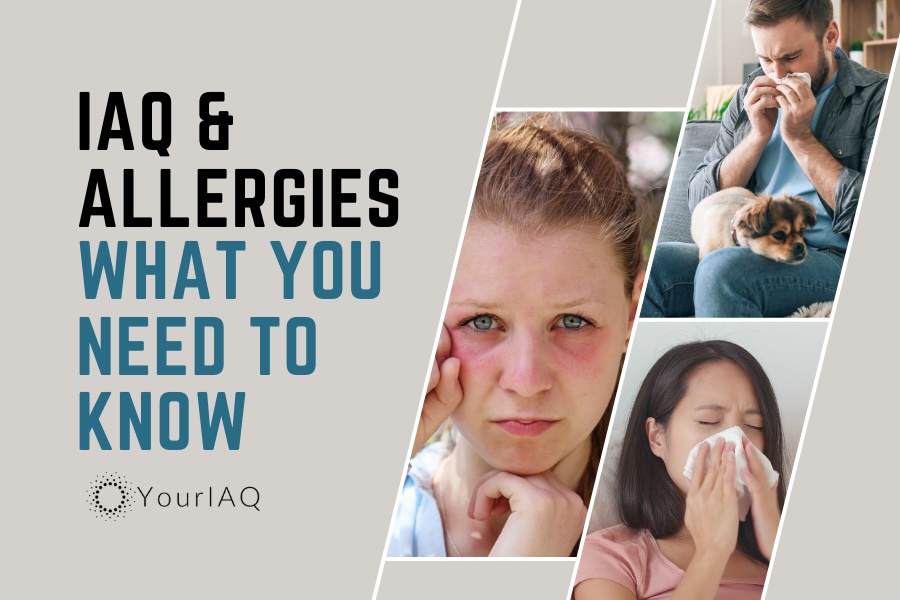
In the hustle and bustle of our daily lives, we often overlook the role air plays in our general wellness. We spend a significant chunk of our lives indoors, and the quality of the air we breathe profoundly impacts our health, especially concerning allergies. In this beginner’s guide, we’ll delve deep into the realm of indoor air quality (IAQ) and allergies, uncovering essential insights to help you manage the air you breathe and minimize the effects of bad allergies.
The Difference Between Seasonal and Indoor Allergies
Many of us are familiar with the sneezing fits and itchy eyes that come with the changing seasons. Seasonal allergies, caused by outdoor factors like pollen, differ significantly from indoor allergies triggered by dust mites, mold, pet dander, and more. While outdoor allergies are hard to control, understanding and managing indoor allergies are within our grasp.
Identifying Common Indoor Allergens
Let’s meet the usual suspects: dust mites, mold spores, pet dander, and insect droppings. These microscopic troublemakers are common indoor allergens that can wreak havoc on your health. Dust mites thrive in bedding and upholstery, while mold lurks in damp areas. Pet dander is self-explanatory! With all of these culprits, identifying the allergen is the first step toward controlling indoor allergies.
See also: 9 Celebrities With Allergies
Humidity Control and Allergies
Maintaining the right indoor humidity levels is a game-changer. Too much humidity encourages mold growth, while too little can lead to dry skin and irritated respiratory passages. Investing in a dehumidifier for damp spaces and a humidifier for dry ones can help strike the perfect balance, keeping allergens at bay
Further reading: Reducing Humidity in Your Home: Practical Tips
IAQ and Children’s Allergies
Children are particularly vulnerable to poor indoor air quality. Exposure to allergens during their early years can lead to chronic allergies and respiratory issues, including asthma. To safeguard the little ones, ensure proper ventilation, clean frequently, and consider investing in an air purifier. Also, encourage outdoor play to balance indoor exposure.
Allergy-Friendly Home Products
Thankfully, technology has our back! Consider allergy-friendly home products like hypoallergenic bedding, vacuum cleaners with HEPA filters, and air purifiers. These products are designed to trap allergens effectively, providing you with cleaner indoor air and reducing the chances of allergic reactions.

Allergy-Proofing Your Home: Practical Tips for a Healthier Living Space
Let’s talk prevention. Allergy-proofing your home involves simple yet effective strategies. Use allergen-proof covers on mattresses and pillows, wash bedding in hot water weekly, vacuum carpets and upholstery regularly, and keep pets out of bedrooms. These small changes can make a significant difference in your indoor air quality.
FAQs: Allergies and IAQ
Can indoor plants help improve indoor air quality?
Yes, certain plants like spider plants and peace lilies can naturally purify indoor air by absorbing toxins.
How often should I change the filters in my air purifier?
Filters should be changed according to the manufacturer’s instructions, usually every 3 to 6 months.
Can carpeting worsen indoor allergies?
Yes, carpets can trap allergens. Consider hypoallergenic rugs or opting for hardwood or tile flooring.
Is opening windows a good way to improve indoor air quality?
It can help if outdoor air quality is good, but during high pollen seasons, it might worsen allergies. Use window screens to reduce allergen entry.
What role do air purifiers play in managing indoor allergies?
Air purifiers with HEPA filters can effectively trap allergens, improving indoor air quality and reducing allergy symptoms.
Breathe Easy, Live Healthy
Improving indoor air quality isn’t just about comfort; it’s about your health and well-being. By understanding the nuances of indoor allergies and implementing simple yet effective measures, you can create a healthier living environment for you and your family. For more in-depth insights and resources, refer to government agencies and professional associations like those mentioned below.
References
| Name | Description | Link |
| Environmental Protection Agency (EPA) | U.S. government agency providing valuable information on indoor air quality, allergens, and practical tips for improving air quality. | https://www.epa.gov/indoor-air-quality-iaq |
| American Lung Association | Leading non-profit organization offering resources and expertise on lung health, including articles and guides related to indoor air quality and allergies. | https://www.lung.org/ |
| Allergy and Asthma Foundation of America (AAFA) | National non-profit organization providing education and support for individuals with allergies and asthma, offering valuable insights on managing indoor allergies. | https://aafa.org/ |







